Performance Programmatic Platforms follow the same rules as traditional programmatic platforms, but the focus on performance campaigns is to optimize ad placements through real-time bidding and enable data-driven decision-making.
These platforms buy and place ads for advertisers with targeting functionalities, dynamic creative optimization, and performance analysis. As they market themselves, the entire process is ML and algorithm-driven. However, there is a prevailing myth that these platforms are fraud-free. Even MMPs are failing to do anything to curb these frauds because they have no protection at the impression level and minimum protection at clicks. Let’s delve deeper to burst the myth and highlight what advertisers need to do to optimize campaigns on performance programmatic platforms.
Table of Contents
ToggleThe Myth of Fraud-Free Performance Programmatic Platforms
With the sophisticated technology behind performance programmatic advertising, these platforms are propagated to be fraud-free. This misconception arises from the belief that advanced algorithms and data-driven strategies can fully protect against fraudulent activities.
However, fraudulent activities such as click fraud, impression fraud, and fake installs continue to plague the programmatic advertising ecosystem. Fraudsters constantly evolve their tactics to exploit system vulnerabilities.
Many programmatic platforms claim to have robust ad fraud detection solution mechanisms, but these measures often fall short in practice. That’s where a third-party independent validator is needed. The sheer volume of transactions and the complexity create numerous opportunities for invalid traffic to slip through the cracks.
Type of Fraud on Performance Programmatic Platforms
1. Impression Fraud: Impression injection artificially inflates the number of ad impressions, executed by generating fake impressions in the background, later if the user downloads and installs an application organically or inorganically, the attribution gets stolen. This technique manipulates the ad delivery system to make it appear as though ads are being viewed more frequently than they are.
2. Click Fraud: Fraudsters generate fake ad requests that make it appear as though legitimate users are viewing ads. These can be triggered by bots or automated scripts.
3. Imperceptible Window: Ads may be loaded in ways that are invisible to the user, such as in a background process or in a 1×1 pixel iframe, ensuring they are not seen by actual humans.
4. Ad Stacking: Sometimes multiple ads are stacked on top of each other, but only one is visible. Each ad in the stack registers an impression, leading to inflated impression counts.
5. Fraudsters also exploit software development kits (SDKs) within legitimate apps to load ads in the background without the user’s knowledge.
6. Fake Devices: non-genuine or simulated devices to generate fraudulent ad activity or BOT-based impressions that are totally junk. Fraudsters use device emulators or simulators to mimic the behavior of multiple real devices. This allows them to generate fake traffic at a scale.
7. Device Farms: collections of physical devices, often managed by automated systems, that repeatedly engage with ads to create the illusion of genuine user activity. Fraudsters also manipulate device identifiers, such as Android Device IDs, to create fake device profiles.
8. IP Fraud: Fraudsters also use Invalid IP (use of VPNs) and get impressions from regions not targeted which results in high impressions but low ROI.
Challenges in Optimizing Ad Campaigns
1. Myth of No Ad Fraud: The first thing is busting the bubble and countering the myth that there is no fraud on impressions, programmatic-based partners, or programmatic performance. Once advertisers accept the fact then proactive measures for full-funnel protection can be put in place to tackle ad fraud at every level and elevate campaign performance.
2. Brand Safety Issues: Next is combating brand safety issues with safe and relevant placement, protecting brand reputation.
3. Frequency Cap Violations: The most common and often neglected issue is FCAP violations along with bots spamming impressions for payouts. Brands need to be vigilant and identify F-cap violations to make sure their ad reaches the broader and relevant audience and is not seen by similar sets multiple times to generate impressions leading to ad fatigue, not conversions.
4. Down-the-funnel KPIs are ignored: Aggregators also mix traffic and sell it by the name of premium inventory. In case of fraud, the clean publisher gets a bad reputation. Since the organic is stolen, down the funnel, is going to be met.
Limitations of Mobile Measurement Partners (MMPs)
MMPs provide insights into user behavior, campaign effectiveness, and ROI. However, their ability to curb fraud is limited.
1. MMPs typically focus on tracking clicks and conversions but have minimal protection against impression fraud.
2. Impression fraud involves generating fake ad impressions to inflate metrics, which can mislead advertisers about the reach and effectiveness of their campaigns. While MMPs do have mechanisms to identify and filter out invalid clicks, these protections are often not comprehensive enough to detect all fraudulent clicks.
3. Another key issue with MMPs is attribution challenges as fraudsters often use tactics like click injection and click spamming to manipulate attribution models. MMPs, despite their advanced analytics, can struggle to differentiate between legitimate user actions and fraudulent activities, leading to incorrect attribution and wasted ad spending.
Let’s get a better understanding of the challenges and how mFilterIt helped resolve them
Case 1:
How A Popular Gaming Brand Optimizes Performance in USA – App Campaign
For instance, Let’s take the case of a trusted and most popular gaming platform in the US. The app offers a variety of games across a range of categories, such as card games, casual games, etc.
Fraud at Impression Level: On Android, the fraud at the impression level was as high as 33% among over 56 million impressions generated, while on the iOS platform, 14% fraudulent impressions were detected among 4.8 million impressions. The major chunk of fraudulent
impression was due to impression Injection, and the rest came from Invalid IP addresses, or sophisticated invalid traffic (SIVT).
Fraud At Click Level: Among million and above clicks 11% were fraudulent on the Android platform. 6.13% of clicks were generated via click Injection and 3.69% came from fake devices while on the iOS platform, among 98, 800 plus clicks, 6% were deemed fraudulent. The breakdown of these fraudulent clicks included 2.13% from Click Injection and 1.79% coming from Invalid IP addresses.
Case 2:
A leading travel and tourism brand Case: Need for Frequency Cap Violations Monitoring
The key challenge for brands was multiple impressions from the same Google Advertising ID (GAID). It is a unique identifier assigned to each Android device by Google. GAID helps advertisers track user activity to deliver personalized ads, measure ad performance, target users effectively, and attribute ad interactions to specific campaigns. It ensures that the ads shown to users are relevant to their interests. Users can reset their GAID or opt out of personalized advertising through their device settings, enhancing their privacy control.
In this case, out of 167 million impressions, 49.7 million impressions (30%) were shown to users more than 10 times a day.
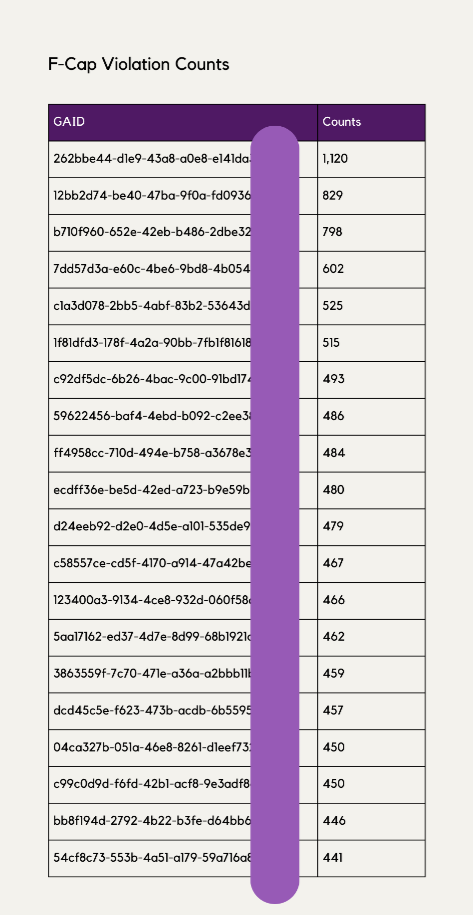
A quick succession of impressions generated from same GAID: Another issue is a single GAID with a massive amount of impressions in a short period and in quick succession, for instance, GAID: 262bbe44-d1e9-43a8-a0e8-e********** generated1,120 impressions! These impressions were not only coming so excessively but were also being shown quickly.
Multiple Impressions in a Short Period: As shown in the following table, a single GAID generates multiple impressions quickly.
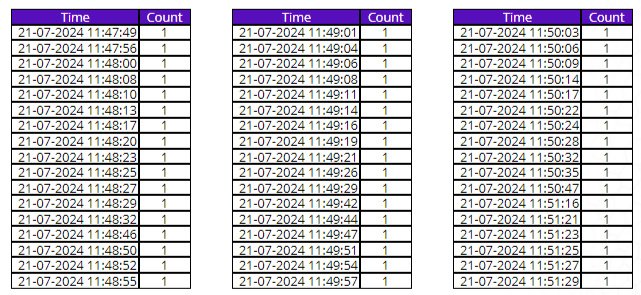
Impression Injection: For instance, 1.9M impressions were recorded from subnets 152.58.** and 152.59.** which reflect that the usage of device farm to fire multiple impressions.
A subnet, or subnetwork, is a segmented piece of a larger network. Subnets divide a larger network into smaller, more manageable sections. Each device on a network is assigned an IP address, and subnets use a portion of these addresses to define network segments. The first three octets (192.168.1) represent the network, while the last octet (1) identifies the specific device (host) within that network. Surprisingly, only 373 Installs came from this pool of IPs with Zero Transaction Events!
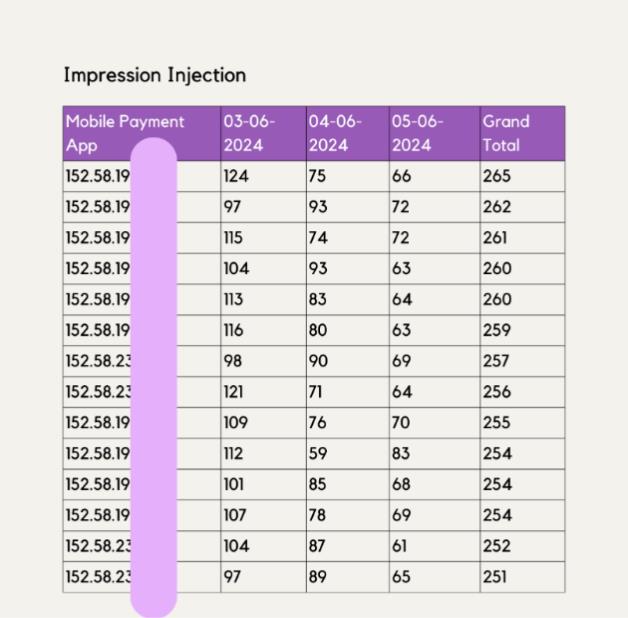
IP Repetition: Same IP, different users reflect high chances of fake impressions being injected with different GAIDs, with more than 99% unique users, as shown in the figure below same IP generating multiple impressions. For instance, IP 152.58.1**.** generated 2,961 impressions
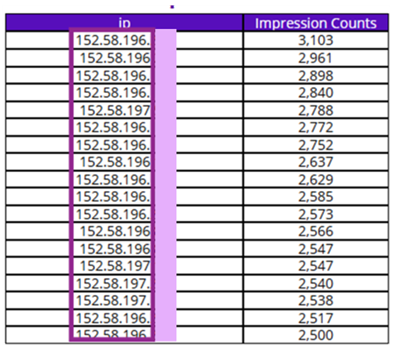
Same IP, Different Impressions: The issue is not limited to IP repetition, but it extends further with the same IP generating multiple unique GAIDs and different impressions. As shown in the figure below. 54% of unique GAIDs generated 3,103 impressions for the same IP.
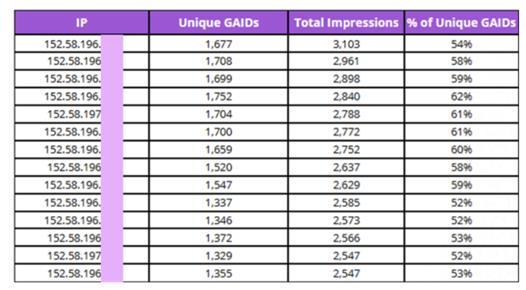
What Advertisers Should Do?
Real-time monitoring is needed to track impressions in real-time and monitor how often your ads are being shown to the same users with immediate alerts that notify you when the frequency cap is about to be breached. Cross-channel tracking with a unified view enables monitoring of ad exposures across all channels such as CTV, social media, display, etc. Regularly analyze campaigns, and review performance metrics such as click-through rates (CTR) and conversion rates to identify signs of ad fatigue. If performance dips, consider lowering the frequency cap or refreshing ad creatives.
Monitoring Frequency Cap (F-Cap) violations is crucial to avoid spamming. Firstly, Set Clear Frequency Limits – Define the Cap that establishes a maximum number of ad exposures per user within a specified time frame, for instance, no more than 3 ads per user per day. Make sure you adjust for campaign type to ensure a customized frequency cap based on the campaign goals for instance, brand awareness might allow for higher caps than direct response campaigns.
Another effective way is Ads.txt. It helps prevent unauthorized ad inventory sales by allowing app developers to declare who is authorized to sell their ad inventory. To enhance transparency in the advertising ecosystem “App Ads.txt” is a standard designed for mobile apps. It’s similar to the Ads.txt for websites but tailored for apps. As it clears the air about the need of Ads.txt to ensure transparency in the ecosystem.
Final Thought
Advertisers need regular audits and real-time protection to build trust and transparency while running campaigns on performance programmatic platforms. mFilterIt, Valid8 app traffic validation and ad fraud prevention leverage AI and ML that automatically adjust frequency caps based on real-time data and predicted user behavior.
mFilterIt Valid8 not only protects your impression integrity, prevents fraud at click and impression level but also monitors F-Cap violations in real-time. Additionally, it will also help to reduce MMP costs. Third-Party verification tools are also needed to ensure adherence to frequency caps and to gain additional insights. Ensure that ad agencies and networks you work with are adhering to your frequency cap policies with transparency in reporting.
Get in touch to know more about programmatic advertising.




